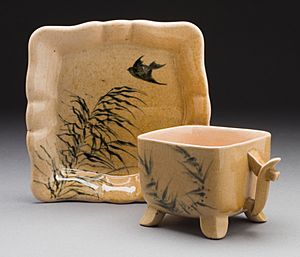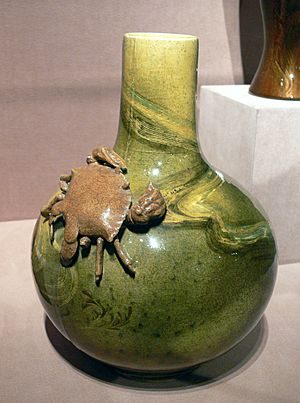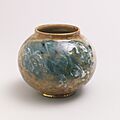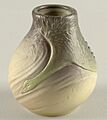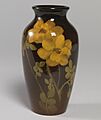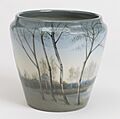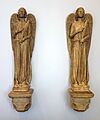Rookwood Pottery Company facts for kids
Quick facts for kids |
|
|
Rookwood Pottery
|
|

pottery buildings in 1904
|
|
| Location | Cincinnati, Ohio |
|---|---|
| Built | 1892 |
| Architect | H. Neill Wilson (and later expanded) |
| NRHP reference No. | 72001023 |
| Added to NRHP | December 05, 1972 |

Rookwood Pottery is a famous American company that makes beautiful ceramic art. It was started in 1880 and became very popular for its unique decorative pottery. The company closed in 1967 but was brought back to life in 2004. Rookwood Pottery began in the Over-the-Rhine neighborhood of Cincinnati, Ohio, and it's now back in that same area. From about 1890 until the 1929 Crash (a time when the economy struggled), Rookwood was a very important maker of fancy American art pottery in many popular styles.
Contents
The Story of Rookwood Pottery
How Rookwood Pottery Started
Maria Longworth Nichols Storer founded Rookwood Pottery in 1880. She was the daughter of a rich man named Joseph Longworth. Maria was inspired by the amazing pottery she saw at the Centennial Exhibition in Philadelphia, especially pieces from Japan and France.
The first Rookwood Pottery was in an old school building on Eastern Avenue. Maria's father had bought this building in March 1880. Maria named the company Rookwood after her father's country home near Walnut Hills. The very first pottery pieces came out of the kiln (a special oven for firing pottery) on Thanksgiving Day that year. After many years of trying out different glazes (shiny coatings) and kiln temperatures, Rookwood pottery became well-known. It was designed to be both decorative and useful.
Rookwood was also special because it hired many women artists. Emily Faithfull, a writer, even mentioned in her book Three Visits to America how successful Rookwood Pottery was under Maria's leadership. She noted that women workers made beautiful items like "Limoges jugs."
Clara Chipman Newton was an important helper and record-keeper for the pottery during its first ten years. She also decorated china and helped Maria oversee the decorating and glazing. The artist Laura Anne Fry also worked at Rookwood as a painter and teacher from 1881 to 1888.
The second Rookwood Pottery building was built in 1891–1892 on top of Mount Adams. It was designed by H. Neill Wilson, whose father was also a famous architect in Cincinnati.
E. T. Hurley was one of the early artists who decorated pottery at Rookwood. He joined in 1896 and worked there for over 50 years. He studied art at the Cincinnati Art Academy. Hurley was known for painting landscapes and nature scenes. He even won a gold medal at the 1904 St. Louis World's Fair for his pottery work.
Types of Pottery and Glazes
The very first pieces from Rookwood Pottery had designs carved into colored clay. These clays were red, pink, gray, and sage green. Some pieces were gilded (decorated with gold) or had stamped patterns. Often, people would buy these unfinished pieces and decorate them themselves. However, these self-decorated pieces are not usually considered true Rookwood for collecting.
Later, Maria Storer wanted Rookwood to have a special look. She created the "Standard Glaze." This was a clear, shiny glaze with a yellow tint, often used over designs of leaves or flowers. They also made portraits, often of American Indian characters, using this Standard Glaze. A rare and valuable version of the Standard Glaze was called "tiger eye." It appeared only on red clay and created a golden shimmer deep inside the glaze. However, it was hard to predict how this glaze would turn out.
Rookwood also made pottery in the Japonism style, which was popular at the time and inspired by Japanese art. This happened after Maria Storer invited Japanese artist Kitaro Shirayamadani to work for the company in Cincinnati in 1887. Rookwood's pieces were even shown at the Exposition Universelle in Paris in 1889.
In 1894, Rookwood introduced three new glazes: "Iris" (a clear, colorless glaze), "Sea Green" (a clear, green-tinted glaze), and "Aerial Blue" (a clear, blue-tinted glaze). Aerial Blue was only made for one year, but Iris and Sea Green were used for more than ten years.
As the American Arts & Crafts Movement grew, there was a need for a matte (not shiny) glaze. This glaze could be used over decorations painted under the glaze, usually flowers and scenes. Rookwood introduced a "Vellum" glaze in 1904. It had a matte surface, but you could still see the slightly frosted-looking decoration underneath. Rookwood artist Sara Sax experimented with this translucent vellum glaze and relief carving.
One of the last glaze types Rookwood made was "Ombroso," which appeared after 1910. Ombroso was a brown or black matte glaze used on pottery that was cut or carved.
Architectural Pottery and Success
In 1902, Rookwood started making pottery for buildings. This part of the company quickly became famous across the country and even internationally. Many flat pieces were used around fireplaces in homes in Cincinnati. Larger, custom pieces were installed in grand homes, hotels, and public places.
You can still see original Rookwood tiles in places like Carew Tower, Union Terminal, and Dixie Terminal in Cincinnati. The Rathskeller Room at the Seelbach Hilton in Louisville, Kentucky, also has them. In New York City, the Vanderbilt Hotel, Grand Central Station, Lord & Taylor, and several subway stations feature Rookwood tiles. One of the most important Rookwood tile displays is at the Carnegie West Branch of Cleveland Public Library. It shows a picture of Durham Cathedral in England.
The 1920s were a very successful time for Rookwood. The company had about 200 workers, including sculptors like Louise Abel and Erwin Frey. Almost 5,000 visitors came to the Mount Adams factory each year.
Challenges and Decline
The company faced big problems during the Great Depression, a time when the economy was very bad. People stopped buying art pottery, and architects couldn't afford Rookwood tiles anymore. By 1934, Rookwood lost money for the first time. By 1936, the company was only working about one week a month. Some employees left and started a new company called Kenton Hills Porcelains in Erlanger, Kentucky.
On April 17, 1941, Rookwood had to file for bankruptcy. Even though the company changed owners during these hard times, the Rookwood artists mostly stayed.
In 1959, the Herschede Clock Company bought Rookwood. Production moved to Starkville, Mississippi. But the company could not recover from the problems of the Great Depression, and production stopped completely in 1967.
The Revival of Rookwood Pottery
By 1982, there were talks about selling Rookwood to companies overseas. But Michigan dentist and art collector Arthur Townley used all his savings to buy everything that was left of Rookwood. During his time as owner, Townley made small amounts of pottery to keep the original trademarks active. He refused to sell Rookwood for over twenty years.
Finally, in 2004, Townley worked with Cincinnati investors Christopher and Patrick Rose to bring the company back to Cincinnati. In July 2006, after about a year of talks, the Rookwood Pottery Company bought all the remaining original assets from Townley. This included the trademarks, more than 2,000 original molds, and hundreds of glaze recipes.
In 2011, Martin Wade and Marilyn Scripps became the sole owners of the company. Today, Rookwood Pottery works from a studio in the historic Over-the-Rhine neighborhood of Cincinnati. The company is making pottery again, with new kilns and equipment, and new staff. Rookwood Pottery also works with many important organizations to create awards and special commemorative pieces. For example, Rookwood Pottery artist Roy Robinson designed the Center Court Rookwood Cup for the ATP World Tour tennis tournament.
In 2012, the historic Monroe Building in Chicago finished restoring its original architectural parts. This included fixing and replacing thousands of original Rookwood Pottery tiles. In 2013, a fireplace made by Rookwood Pottery, working with artists from the University of Cincinnati, was put in the Contemporary Arts Center in Cincinnati. Marilyn Scripps, one of the owners, said that their goal was to make Rookwood Pottery a forward-thinking company again, willing to take chances and be a leader in the industry. That same year, Rookwood Pottery was featured on the Martha Stewart Living Blog and on the Science Channel show How It's Made.
In 2015, the company worked with Cincinnati artist Kevin Auzenne to create special baseball-themed tiles. In 2017, Rookwood Pottery Company and the Cincinnati Zoo teamed up to create a Fiona ornament. This ornament was dedicated to Fiona, a baby hippo who was born early.
You can see a special gallery of Rookwood Pottery in the Cincinnati Wing of the Cincinnati Art Museum. Also, amazing Rookwood pieces are shown at the Museum of the American Arts and Crafts Movement in St. Petersburg.
Images for kids
-
Panel of Rookwood tiles of Durham Cathedral
-
The original buildings in 2011, seen from Holy Cross Monastery




